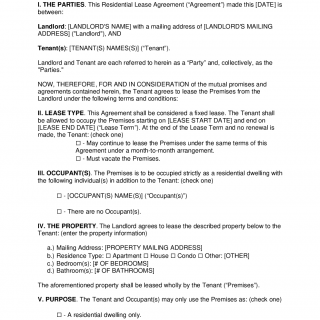Lease Agreement for Residential Property
A Lease Agreement for Residential Property is a legally binding contract between a landlord and a tenant for the lease of residential property. This form outlines the terms and conditions of the lease, including the rent, the duration of the lease, the responsibilities of the landlord and the tenant, and any other details that are important to the agreement.
The Lease Agreement for Residential Property typically consists of several parts, including:
- Identification of the parties: This section should identify the landlord and the tenant by name and address.
- Property description: This section should describe the property that is being leased, including the address and any specific details about the property.
- Term of the lease: This section should specify the duration of the lease, including the start and end dates.
- Rent: This section should specify the amount of rent that will be paid by the tenant and the due date for each payment.
- Security deposit: This section should detail the amount of the security deposit, the conditions for its return, and any deductions that may be made from the deposit.
- Utilities and other fees: This section should identify any fees or charges that the tenant is responsible for, such as utilities or maintenance and repair costs.
- Use of the property: This section should outline how the property can be used and any prohibited uses.
- Maintenance and repairs: This section should specify the responsibilities of the landlord and the tenant for maintaining and repairing the property.
- Termination and renewal: This section should specify the conditions under which the lease can be terminated or renewed.
A Lease Agreement for Residential Property is typically drawn up when a landlord wants to lease their residential property to a tenant. The lease agreement is designed to protect the rights of both parties and ensure that the lease of the property is carried out in a legal and fair manner.
When compiling a Lease Agreement for Residential Property, it is important to take into account the specific needs and requirements of both the landlord and the tenant. For example, the landlord may require a certain term for the lease or specific tenant responsibilities, while the tenant may require certain concessions or accommodations.
The advantages of a properly executed Lease Agreement for Residential Property is that it provides a clear and legally binding agreement outlining the terms and conditions of the lease. When the form is filled out incorrectly, it can cause problems for both the landlord and the tenant. If important terms are omitted or if there are errors in the agreement, the contract may be deemed invalid, and both parties may face legal consequences.
Therefore, it is essential that a Lease Agreement for Residential Property is prepared by a competent and experienced person or with the assistance of legal counsel to ensure that it is thorough, accurate, and complies with all applicable laws and regulations.

